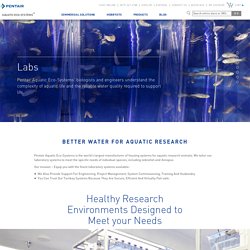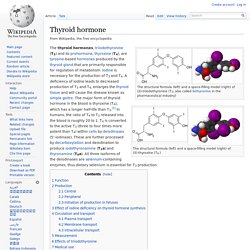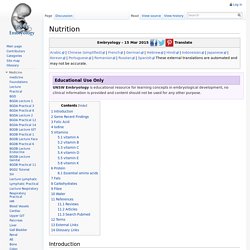

Mapping hematopoiesis in a fully regenerative vertebrate: the axolotl. Labs & Aquatic Research. We set the standard for aquaria rack systems and provide unparalleled customer support to our worldwide customer base.

Aquatic Habitats Care Plan The best way to maintain your system and keep your research safe. Learn More G-HAB Systems A great choice for toxicology-related studies in which plastic tanks may not be ideal. Get G-HAB Details MEPS® Mass Embryo Production System Designed specifically for the production of large numbers of zebrafish embryos for drug screening, toxicology assays/experiments or propagation of fish. MEPS Details MEPS® Mini Mass Embryo Production System Designed specifically for the production of large numbers of zebrafish embryos for drug screening, toxicology assays/experiments or propagation of fish.
X-HAB Systems The X-Hab line is Xenopus sp. frogs or other mid-sized aquatic animals. Complete Details Z-HAB Systems The Z-Hab is one of our proven, time-tested zebrafish housing systems. Read More Z-HAB Duo Systems Double the capacity while minimizing maintenance. More Info. Rebuilding a heart: complete regeneration after myocardial infarction in the axolotl (1151.1) Forskningsdatabasen.dk. Axolotl anatomy. Neoteny. This diagram shows that the head becomes proportionately smaller and the legs become proportionately longer as humans mature.

This implies that proportionately large heads and proportionately short legs would be neotenous features for adults. Neoteny is one of three dimensions of heterochrony, or the change in timing of developmental events: acceleration (faster) vs. neoteny (slower), hypermorphosis (further) vs. progenesis (not as far), and predisplacement (begins earlier) vs. postdisplacement (begins later).[9] The word neoteny is borrowed from the German Neotenie, the latter constructed from the Greek νέος (neos, "young") and τείνειν (teínein, "to extend").
The adjective form of the word is either "neotenic" or "neotenous".[10] For the opposite of "neotenic", different authorities use either "gerontomorphic"[11] or "peramorphic".[12] In humans[edit] Neotenic traits in humans[edit] Various sources identify the following: Human evolution[edit] Stanley Greenspan and Stuart G. Caroline F. M. Neural crest. Neural crest cells are a transient, multipotent, migratory cell population unique to vertebrates that gives rise to a diverse cell lineage including melanocytes, craniofacial cartilage and bone, smooth muscle, peripheral and enteric neurons and glia.[1] After gastrulation, neural crest cells are specified at the border of the neural plate and the non-neural ectoderm.

During neurulation, the borders of the neural plate, also known as the neural folds, converge at the dorsal midline to form the neural tube. Subsequently, neural crest cells from the roof plate of the neural tube undergo an epithelial to mesenchymal transition, delaminating from the neuroepithelium and migrating through the periphery where they differentiate into varied cell types.[1] The emergence of neural crest was important in vertebrate evolution because many of its structural derivatives are defining features of the vertebrate clade.[2] History[edit] Induction[edit] Thyroid hormone. The structural formula (left) and a space-filling model (right) of (S)-triiodothyronine (T3, also called liothyronine in the pharmaceutical industry) The structural formula (left) and a space-filling model (right) of (S)-thyroxine (T4.)

Function[edit] Thyroid hormone leads to heat generation in humans. However, the thyronamines function via some unknown mechanism to inhibit neuronal activity; this plays an important role in the hibernation cycles of mammals and the moulting behaviour of birds. One effect of administering the thyronamines is a severe drop in body temperature. Production[edit] Central[edit] Thyroid hormones (T4 and T3) are produced by the follicular cells of the thyroid gland and are regulated by TSH made by the thyrotropes of the anterior pituitary gland.
Thyroxine (3,5,3',5'-tetraiodothyronine) is produced by follicular cells of the thyroid gland. Salamander heart regeneration. File:Thyroid hormone homeostasis.jpg - Embryology. Gene-expression-in-thyroxininduced-metamorphosing-axolotl-hearts-2329-6607.1000e122.pdf. Nutrition - Embryology. Educational Use Only UNSW Embryology is educational resource for learning concepts in embryological development, no clinical information is provided and content should not be used for any other purpose.

Introduction Folate Fruits This current page is a start page for your exploration of topics related to nutrition and development. While there are many sites and information available concerning postnatal nutrition, prenatally research has mainly focussed on developmental effects of specific deficiencies (folate and iodine) and the teratogenic effects of retinoic acid. See also the National Health and Medical Research Council (NHMRC) publication NHMRC - Nutrient Reference Values for Australia and New Zealand Including Recommended Dietary Intakes.[1] "The Nutrient Reference Values outline the levels of intake of essential nutrients considered to be adequate to meet the known nutritional needs of practically all healthy people for prevention of deficiency states. In Australia and New Zealand Fats. Regeneration of Limb Joints in the Axolotl (Ambystoma mexicanum)